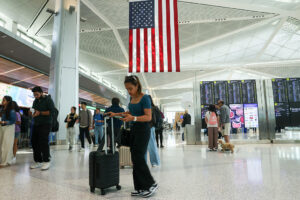
SYDNEY — Australia’s economy grew solidly in the first quarter, shrugging off omicron-related disruptions and east coast floods earlier in the year, with cashed-up consumers continuing to drive the expansion.
The economy grew 0.8% in the first quarter from the previous quarter, and by 3.3% from a year earlier, the Australian Bureau of Statistics said Wednesday. Economists had expected GDP growth of 0.6% for the quarter and 3.0% for the year.
Australia, a big exporter of iron ore and energy products, is benefiting from higher commodity prices as a result of the conflict in Ukraine. Still, China’s zero tolerance for COVID-19 cases looms as a substantial headwind, with well over one-third of Australia’s exports destined for ports on China’s east coast.
High demand for Australia’s mining and rural commodities amid supply constraints in other producing nations and global uncertainty contributed to the rise in export prices. Mining profits rose 14.7% to reach 69 billion Australian dollars (US$49.52 billion), reflecting strong commodity prices across coal, liquefied natural gas and iron ore, the statistics bureau said.
Still, Australia’s domestic outlook appears bumpier as surging inflation has prompted the Reserve Bank of Australia to raise rates at speed. The RBA delivered its first interest-rate increase in over a decade in May, acknowledging that it had underestimated the strength of price increases across the economy.
Inflation rose at its fastest pace in over 20 years in the first quarter, with economists expecting worse in coming quarters.
House prices have already begun to fall amid concerns that the central bank may need to be more aggressive when tightening interest rates than most economists expect. Some economists are tipping falls of 15% over the coming cycle, denting confidence.
Financial markets expect the RBA will deliver multiple rate increases by the end of the year, with more to come in 2023.
The incoming Labor government, which was returned to power on May 21 after nine years in opposition, is also faced with the task of massive budget repair after generous stimulus was deployed to keep the economy growing through two years of COVID-19 shutdowns.
Consumer confidence is already flagging as the prospect of higher interest rates, rising living costs and falling real wages combine to cool spending.
Australia’s terms of trade rose 5.9% in the first quarter, with export and import prices both up strongly, the statistics bureau said.
Household and government spending drove growth, with total final consumption contributing 1.4 percentage points to GDP in the first quarter. Household spending rose 1.5% with increases across a number of discretionary categories, the ABS said.
Following the easing of COVID-19 restrictions, household spending on transport services, hotels, cafes and restaurants, and recreation and culture increased, the ABS said.
The household saving-to-income ratio fell to 11.4% from 13.4% as the increase in household spending outpaced growth in household income, it added.
Imports of goods and services rose 8.1%, with net exports shaving 1.5 percentage points from GDP.







